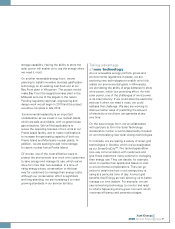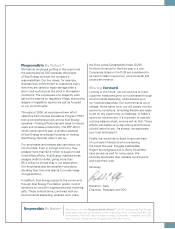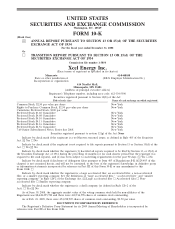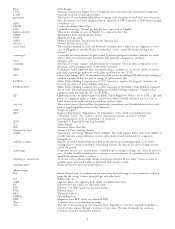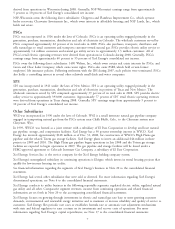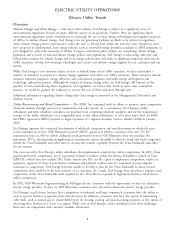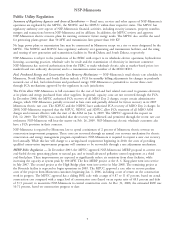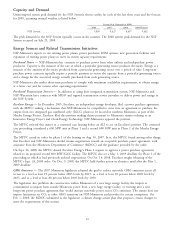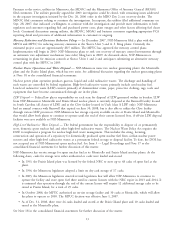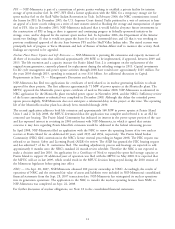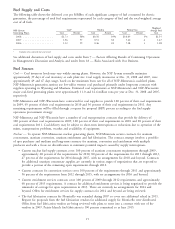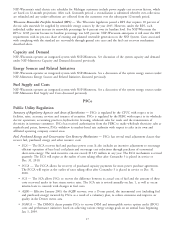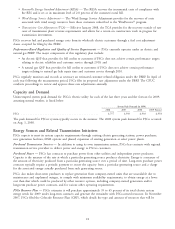Xcel Energy 2008 Annual Report Download - page 19
Download and view the complete annual report
Please find page 19 of the 2008 Xcel Energy annual report below. You can navigate through the pages in the report by either clicking on the pages listed below, or by using the keyword search tool below to find specific information within the annual report.NSP-Minnesota
Public Utility Regulation
Summary of Regulatory Agencies and Areas of Jurisdiction — Retail rates, services and other aspects of NSP-Minnesota’s
operations are regulated by the MPUC, the NDPSC and the SDPUC within their respective states. The MPUC has
regulatory authority over aspects of NSP-Minnesota’s financial activities, including security issuances, property transfers,
mergers and transactions between NSP-Minnesota and its affiliates. In addition, the MPUC reviews and approves
NSP-Minnesota’s electric resource plans for meeting customers’ future energy needs. The MPUC also certifies the need
for generating plants greater than 50 MW and transmission lines greater than 100 KV.
No large power plant or transmission line may be constructed in Minnesota except on a site or route designated by the
MPUC. The NDPSC and SDPUC have regulatory authority over generating and transmission facilities, and the siting
and routing of new generation and transmission facilities in North Dakota and South Dakota, respectively.
NSP-Minnesota is subject to the jurisdiction of the FERC with respect to its wholesale electric operations, hydroelectric
licensing, accounting practices, wholesale sales for resale and the transmission of electricity in interstate commerce.
NSP-Minnesota has received authorization from the FERC to make wholesale electric sales at market-based prices (see
market-based rate authority discussion) and is a transmission-owner member of the MISO RTO.
Fuel, Purchased Energy and Conservation Cost Recovery Mechanisms — NSP-Minnesota’s retail electric rate schedules in
Minnesota, North Dakota and South Dakota include a FCA for monthly billing adjustments for changes in prudently
incurred cost of fuel, fuel related items and purchased energy. NSP-Minnesota is permitted to recover these costs
through FCA mechanisms approved by the regulators in each jurisdiction.
The FCAs allow NSP-Minnesota to bill customers for the cost of fuel and fuel related costs used to generate electricity
at its plants and energy purchased from other suppliers. In general, capacity costs are not recovered through the FCA.
In December 2006, the MPUC authorized FCA recovery of all MISO Day 2 charges, except certain administrative
charges, which NSP-Minnesota partially recovered in base rates and partially deferred for future recovery in its 2009
Minnesota electric rate case. The SDPUC and the NDPSC have authorized FCA recovery of MISO Day 2 charges. In
2008, NSP-Minnesota requested that the MPUC, NDPSC and SDPUC allow FCA treatment of all MISO ASM
charges and revenues effective with the start of the ASM on Jan. 6, 2009. The SDPUC approved the request on
Feb. 12, 2009. The NDPSC has concluded that the recovery was addressed and permitted through the recent rate case
settlement. NSP-Minnesota will hear the matter on Feb. 26, 2009. NSP-Minnesota’s electric wholesale customers also
have a FCA provision in their contracts.
NSP-Minnesota is required by Minnesota law to spend a minimum of 2 percent of Minnesota electric revenue on
conservation improvement programs. These costs are recovered through an annual cost recovery mechanism for electric
conservation and energy management program expenditures. NSP-Minnesota is required to request a new cost recovery
level annually. While this law will change to a savings-based requirement beginning in 2010, the costs of providing
qualified conservation improvement programs will continue to be recoverable through a rate adjustment mechanism.
MERP Rider Regulation — In December 2003, the MPUC approved NSP-Minnesota’s MERP proposal to convert two
coal-fueled electric generating plants to natural gas, and to install advanced pollution control equipment at a third
coal-fired plant. These improvements are expected to significantly reduce air emissions from these facilities, while
increasing the capacity at system peak by 300 MW. The first MERP project at the A. S. King plant went into service
in July 2007. The second project at the High Bridge plant went into service in May 2008. The remaining project at
the Riverside facility is expected to begin operations in 2009. The MPUC approved a rate rider to recover prudent
costs of the projects from Minnesota customers beginning Jan. 1, 2006, including a rate of return on the construction
work in progress. The MPUC approval has a sliding ROE scale with a range of 9.87 to 11.47 percent, based on actual
construction cost compared with a target level of construction costs (based on an equity ratio of 48.5 percent and debt
of 51.5 percent) to incentivize NSP-Minnesota to control construction costs. At Dec. 31, 2008, the estimated ROE was
10.71 percent, based on construction progress to date.
9


